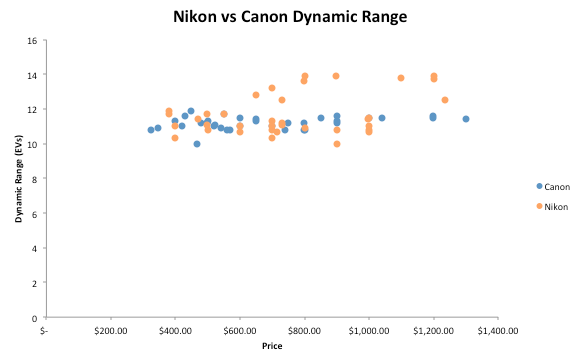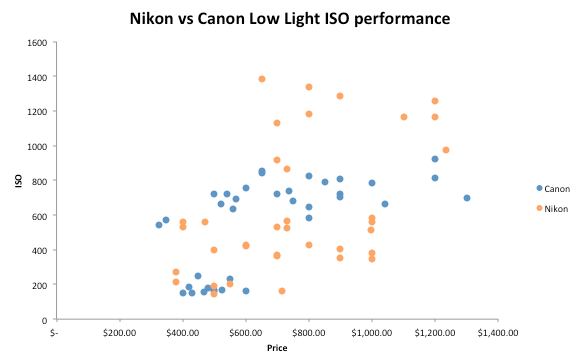Choosing a Nikon for astrophotography
I must admit; the main reason for me to choose a Nikon D7000 to use for astrophotography has very little to do with this model being the best option for astrophotography. I simply already owned a Nikon D7000 for daytime (wildlife) photography when I started with astrophotography.
However, it turned out to be performing very well so I sticked with it for the past 2 years. In fact, it is performing so well that I probably will buy a 2nd Nikon D7000 (update: I actually bought a D5100, same sensor but smaller and cheaper camera 😉 ). And this time I actually am looking into all the different comparisons. But first let’s consider the choice between a Canon vs a Nikon; which is the best camera for astrophotography?
Choosing the right camera
When selecting a DSLR for any kind of photography, you have to carefully think of the specifications and characteristics that are important to you as a photographer. It’s not as simple as just selecting the best camera for astrophotography. Every photographer is different and wants different things, even when we are talking about something as specific as astrophotography.
For me one of the main advantages of a DSLR is the fact that I can work ‘standalone’; no laptop required in the field. Because of this the Liveview and the screen of the camera is more important to me than it would be for someone that is using the DSLR together with a laptop. Furthermore the compatibility with drivers and software is also less of a concern for me and maybe the main reason why I can consider Nikon’s as well and not just the ‘astrophotography standard brand’ Canon. (update: with the release of BackyardNikon also software is no problem anymore for Nikons)
Another thing that is important to me is the sturdiness of a camera; I don’t want to be worried when the camera is dripping wet because of the dew, or when I drop the camera because I didn’t tighten the screws of the focusser (actually happened to me, ouch!).
Of course there are also the ‘standard’ considerations regarding the camera’s chip; how well does it handle the different kinds of noise, how well is the color depth, dynamic range, what is the pixel size, chip size in regards to FOV etc. etc. etc.
Nikon vs Canon for astrophotography: which is the best?
To me the field of astrophotography has become to much ‘Canon-minded’. Mainly due to the fact that there is compatible software available and perhaps due to the astro-models of the Canon, it seems to have become the first choice of every astrophotographer that is using a DSLR. However, looking objectively to the performance of the camera’s and especially the sensor we cannot help but conclude that the Nikons are actually outperforming the Canon camera’s.
This may sound like the typical thing a Nikon owner will say in any ‘Nikon vs Canon’ discussion, but let’s look at some objective data from DxO tests;
Please visit the DxO website for a full overview and comparison of all the sensors.
We can clearly see a whole range of Nikon models consistently outperforming the Canon cameras in terms of the total score for sensor performance. DxO basically looks at 3 things when evaluating the sensor performance; Color Depth, Dynamic Range and Low Light ISO performance. These are all very valid things to consider for astrophotography as well.
I’ve restricted the view a bit based on budget to get a clearer picture. Please note that these prices are the purchase price at the time the model was introduced to the market! Older models will be cheaper obviously, which we will consider later on in the post.
Now let’s look at the breakdown of the performance. First up is the color depth:
The score of color depth is explained by DxO as follows:
“Color sensitivity indicates to what degree of subtlety color nuances can be distinguished from one another, often meaning a hit or a miss on a pantone palette. Maximum color sensitivity reports, in bits, the number of colors that the sensor is able to distinguish.”
Color nuance, especially in star colors, is getting overlooked in astrophotography a lot unfortunately, with to much focus on detail, sharpness and noise to my opinion. But more on that in a later post.
Dynamic Range
Considering star colors, an important factor here is the Dynamic Range. The scores for dynamic range are defined by DxO as:
“Maximum dynamic range is the greatest possible amplitude between light and dark details a given sensor can record, and is expressed in EVs (exposure values) or f-stops, with each increase of 1 EV (or one stop) corresponding to twice the amount of light.
Dynamic range corresponds to the ratio between the highest brightness a camera can capture (saturation) and the lowest brightness it can capture (typically when noise becomes more important than the signal, i.e., a signal-to-noise ratio below 0 dB).
A value of 12 EV is excellent, with differences below 0.5 EV usually not noticeable.”
Low Light ISO performance
As mentioned the performance for both color depth and dynamic range drop quite dramatically when turning up the ISO. Considering the fact that for astrophotography you always shoot at higher ISO’s, the Low Light ISO performance can be (arguably) considered to be the most important score for the sensor performance.
Basically this scores tells us at what ISO we can still benefit from good dynamic range and color depth and thus can be also considered to be taking the previous 2 scores into account.
Please note that this isn’t the best ISO to use for astrophotography in most cases!
DxO defines this score as:
“The SNR indicates how much noise is present in an image compared to the actual information (signal). The higher the SNR value, the better the image looks, because details aren’t drowned by noise. SNR strength is given in dB, which is a logarithmic scale: an increase of 6 dB corresponds to doubling the SNR, which equates to half the noise for the same signal.
An SNR value of 30dB means excellent image quality. Thus low-light ISO is the highest ISO setting for a camera that allows it to achieve an SNR of 30dB while keeping a good dynamic range of 9 EVs and a color depth of 18bits.”
A top 10 of the best camera’s for astrophotography
Looking at these graphs of course make us wonder which models are the best performing, so lets look at the top 10 based on the low light performance. (This top 10 is only slightly different compared to looking at overall score)
As mentioned before we also should consider the price at current time of these models and possibly the availability on the second hand market.
Disadvantages of Nikon for astrophotography
As mentioned before, the compatibility of Nikon’s with certain software and other equipment is less available than for Canon camera’s. Whether this is a problem for you of course depends on your personal situation and choice of gear and software. For me this isn’t a problem since I don’t want to use a laptop to control my camera and right now I am able to use my Lacerta MGEN autoguiding camera with my Nikon D7000.
Another disadvantage might be the fact that modification of Nikon DSLR’s seems to be more difficult than for Canon bodies. At least it is done less frequently which means it can be more difficult to find someone experienced with this. It can be done, so this doesn’t have to be a problem per se.
Conclusion: which is the best for astrophotography?
Canon is clearly the most used DSLR in astrophotography, but we can reasonably argue that it isn’t the best choice for many people when comparing to a Nikon. When you are looking into buying a new DSLR there are many things to consider, most of which have to do with your personal choice of gear and your desired way of working out in the field. Getting a clear picture of what is most important for you, and looking at actual sensor/camera performance, you might very well end up with a Nikon as your best choice.
In a next post I will compare the top performing models with a more in depth look into the camera’s, in the mean time I’m very interested and curious to hear your own experiences in the comments below!






[…] pictures. So entering this market explicitly is also proving your products are up for the test. Nikon has been outperforming Canon’s in terms of sensor performance for the last couple of years already, so it has been a great option for astrophotography al along. […]
Dutch Digital Works (netherlands) is very experienced in modifying all types of camera’s like Sony A7s, All nikons and Canon. All with full waranty and autofocus restored for use with automatic lenses.
Lot of experience with Nikon.
For those who can afford ~$4k, the Nikon 810A is designed exclusively for astrophotography.
http://dslr-astrophotography.com/nikon-moves-astrophotography-d810a/
This will be my very first camera, Never owned anything before. I was looking at either a Canon 1200D (T5 Rebel) or the Nikon D3300. This has settled it for me and I do believe the Nikon is worth the extra $100 dollars
Software wise. Canon is widely supported and almost all software supports it,
Another fact you failed to mention is that Canon also has made reasonably priced astrophotography cameras that dont require any modification. Nikon has their options that are priced well outside a reasonable amount.
Finally the Digic 2 and higher processor compensate for dark current that hinders astrophotography, Canon does this natively, while other brands require considerable amount of darks to compensate for it.
All these are reason why most go Canon over Sony (which has some amazing sensors) or Nikon that uses Sony sensors!
I don’t agree. There is BackyardNikon, qdslrdashboard, INDI etc. that all support Nikon camera’s just as well as Canon. This is no advantage anymore.
As for the astronomy models; never really understood them to be honest. More expensive and less effective than having it modded yourself.
About the dark current and Digic 2; do you have a source for this? The only way I imagine this would be feasible is to use an in camera dark, which is also available in other brands and is just not a good option. (don’t bother with darks either, in most cases you are only introducing noise. Just dither and take enough frames)
Chris,
Thanks for this article. I have a D7000 that I want to used for widefield astrophotography. Do you know if the D7200 has less noise than the D7000, particularly at high ISOs?
Seems the difference is small (assuming you are shooting RAW) and only 0.2 stops;
http://www.dxomark.com/Cameras/Compare/Side-by-side/Nikon-D7200-versus-Nikon-D7000___1020_680#tabs-2
You did not mention that Nikons do not work with M42 lenses (if you want to focus infinity without modifications or extra lenses), and there are some great, inexpensive manual lenses for astrophotography that will work with Canon, Sony etc.
Also, the DxO marks are not a very good measure of overall quality, although Canon has fallen a bit behind Sony (hence Nikon as well) the last few years.
Two friends in our astronomy club have been using both the Canon T3i and the T5i in the last few years. They have done wonderful photographs with both of these cameras. One photographer does wide field sky photographs, and the other uses his Canon on the back of an 80mm refractor, and the photographs will knock your socks off. My sense is that small differences in performance are unlikely to be seen in these kinds of photographs.